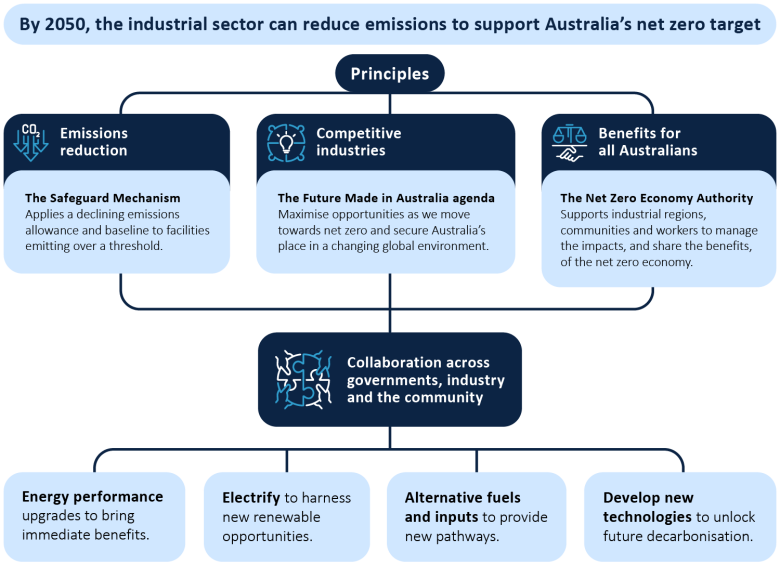As part of the Paris Agreement, Australia has legislated climate action goals in the Climate Change Act 2022, committing Australia to achieve net zero emissions by 2050. The Industry Sector Plan sets out pathways for the Australian industrial and waste sectors to meaningfully reduce direct greenhouse emissions and help businesses transition to net zero.
Australia’s industrial sector is vital to the nation’s economic strength and resilience. It now faces a pivotal transformation amid the global push towards net zero emissions. Traditionally reliant on fossil fuels, the sector must adapt to remain competitive. The transition away from fossil fuel use will be complex, requiring industries and government to work together to navigate evolving energy systems, competition for technology and changing markets. Adapting to address these challenges is fundamentally in Australia’s economic interest, bringing new growth opportunities and supporting competitiveness in a decarbonising global economy. Decarbonising industry is also necessary to meet domestic climate commitments of 62–70% emissions reductions below 2005 levels by 2035 and net zero by 2050.
Securing and strengthening our existing industrial capability and seizing emerging opportunities in the clean economy will be vital to our Future Made in Australia. Capitalising on our advantages will revitalise our industrial base and ensure Australia remains globally competitive, while contributing meaningfully to the national net zero target. Australia has what is necessary to make this transition: abundant minerals and renewable energy resources, infrastructure, an experienced workforce and a world class research and innovation sector.
The Industry Sector Plan provides an overview of the pathway for how Australia’s industry and waste sectors will contribute to meeting the 2030, 2035 and 2050 emissions targets. We created the plan using targeted and ongoing stakeholder engagement, which gave us important insights on opportunities for technology development.
The Industry Sector Plan has 3 principles:
- meaningfully reduce emissions
- maintain and grow competitive industries
- deliver a just and equitable transition.
These principles lean on existing measures including the Safeguard Mechanism, the Future Made in Australia agenda and the Net Zero Economy Authority.
The Industry Sector Plan sets out a clear pathway towards net zero for industries. Optimising energy use through energy efficiency and demand flexibility upgrades will immediately help reduce industrial emissions. Electrifying many industrial processes is a critical next step, allowing businesses to reduce emissions by using renewable electricity. For processes that are unable to electrify now, scaled‑up alternative fuels and inputs like hydrogen and bioresources will become available. Finally, coordinated efforts from Australia’s world leading researchers, innovators, businesses and government will work to bridge technology gaps in sectors that rely on hard‑to‑abate, high‑heat processes. Natural gas usage may still be required for sectors where no other alternatives exist, though abatement is possible through carbon management technologies.
The Australian Government acknowledges industry transition will take time and will need to align with the rollout of renewables and technology development. Heavy industries face compounding challenges that require coordinated efforts from governments and businesses to solve. Many of Australia’s manufacturing and heavy industry hubs are also foundational parts of local economies and communities. We need to carefully consider the social and regional aspects of the industrial net zero transition to ensure it is both equitable and effective. Community engagement and investment in regional workforces, including retraining and education, will win social license for decarbonising Australian industry. Delivering tangible benefits to Australian industry from decarbonisation will also increase community support.
Successfully decarbonising Australia’s industry and waste sectors will significantly benefit the nation, if we can coordinate, manage and balance the process’s ambition and feasibility. This Industry Sector Plan shows how public, private and community stakeholders can work together to reach net zero.

Industry Sector Plan overview
By 2025, the industrial sector can reduce emission to support Australia's net zero target.
Principles.
- Emission reduction: Applies a declining emissions allowance and baseline to facilities emitting over a threshold
- Competitive industries: Maximise opportunities as we move towards net zero and secure Australia's place in a changing global environment.
- Benefits for all Australians: Supports industrial regions, communities and workers to manage the impacts, and share the benefits of the net zero economy.
Collaboration across government, industry and the community.
- Energy performance upgrades to bring immediate benefits.
- Electrify to harness new renewable opportunities.
- Alternative fuels and inputs to provide new pathways.
- Develop new technologies to unlock future decarbonisation.
|
To 2030 Deploy existing opportunities and planning |
|
|---|---|
|
To 2035 Widespread adoption of existing technologies and commercialise new technologies |
|
|
To 2050 Net zero and new market opportunities |
|
